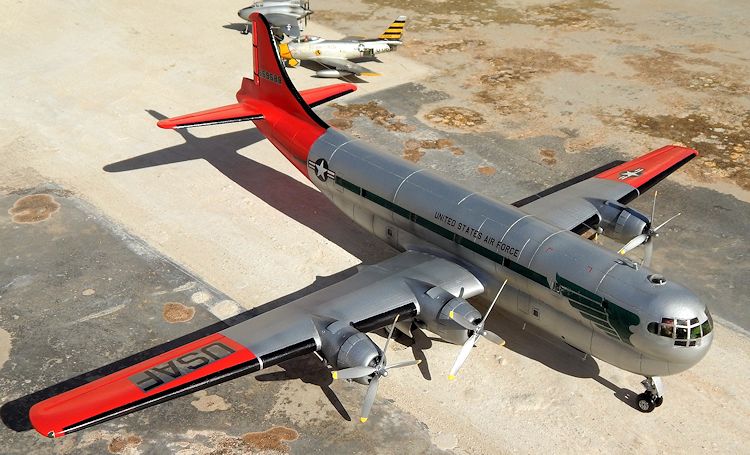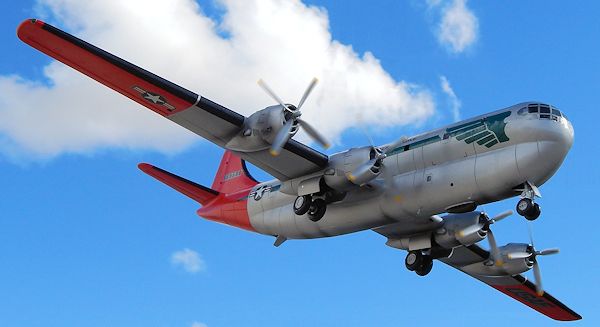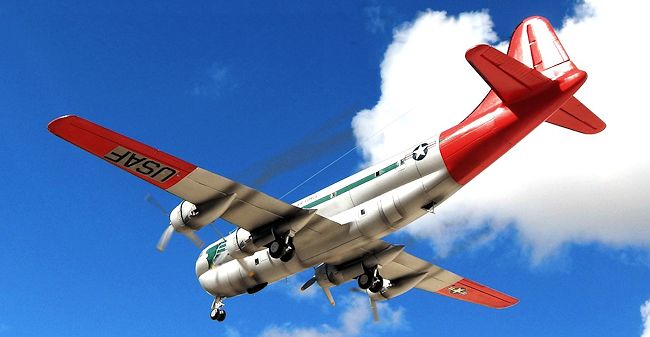
Airmodel/Airfix 1/72 YC-97
| KIT #: | 185 |
| PRICE: | $ |
| DECALS: | None |
| REVIEWER: | Carmel J. Attard |
| NOTES: | Vac-form conversion kit |

| HISTORY |
The C-97s A to L were development of the X-97/YC-97aircraft which was a
transport version of the B-29. Originally designed in 1944 the C-97 was
to the B-29 as the 307 Stratoliner was to the B-17. From the YC-97 then
came the C-97A, B, C, and D which were all transport aircraft used in
M.A.T.S. C-97 u nits
entered service from 1945 with the USAF and Reserve units until more
recent years (late
70s)
when replaced by modern jet tankers and transport type.
nits
entered service from 1945 with the USAF and Reserve units until more
recent years (late
70s)
when replaced by modern jet tankers and transport type.
| THE KIT |
This is basically the Airmodel kit No 185 in 1/72 scale molded in white soft
plastic. The cockpit canopy and also the refuelling bulging aft gondola are
in clear vacform acetate. Apparently at the time of its release (circa 28
years ago) there was also a separate kit conversion to produce a B/KB-50
that was not yet released in injected form at the time. These two Airmodel
kits seemed to borrow parts from each other.

The conversion Airmodel kit was designed for use in conjunction with the
Airfix B-29. It was determined at the early stage to go for a prototype C-97
since there was a wide variation between the early mark and later versions.
| CONSTRUCTION |

 together
using liquid cement. Masking tape secured these together until these were
firm enough to hold as one piece.
together
using liquid cement. Masking tape secured these together until these were
firm enough to hold as one piece.
The high tail fin and rudder was then cut from the vac fuselage as this was
that of later version found on KC-97 and was replaced with one from the
Airfix B-29, this time using super glue for a firm joint. Area was
smoothened with filler. Reference was made to scale plans located in
‘Aircraft of the Fighting Powers’. The rest of kit assembly followed that of
the Airfix instructions.
The internal strengthening of wing root and joints at an earlier stage paid
well as it served as good support for the heavy Airfix wings. Tail planes
added and finally cockpit interior was painted and scale crew figures added
before the vac clear canopy lowered into place.
The YC-97 was a service test aircraft. Photos of the aircraft showed it in B-29 type of engine cowlings and propellers, tail unit and wings at the time. An astrodome above cockpit and also a handle bar antenna were added to forward fuselage. A gondola shaped forward radome was carried under the fuselage. This was shaped from half part of a 1,000lb bomb and painted black. This early version had the wire antenna attached to the vertical fin. Nose wheel and main wheels were also identical to those of the B-29 pattern.
| COLORS & MARKINGS |

There is some contention as to the
exact color of the winged motif and fuselage stripe as some color photos may
be misleading making it appear dark blue more than green. This reminds me of
the occasional dilemma, which arises concerning the top camouflage of
Mustang of 365-fighter group, which appears dark blue in most color photos
when in fact it was dark olive drab camouflage on top surfaces.
| CONCLUSIONS |
The subject I have picked definitely is a colorful one reminiscent of those hay
days of the 50s era when every transport, trainer, or
 prototype
aircraft and those operating in the arctic region wore bright high visibility
colors.
prototype
aircraft and those operating in the arctic region wore bright high visibility
colors.
It is with big surprise that with skies
getting so congested with liners and military type no longer is given regard to
these bright high visibility colors, but then it is quite understandable
considering the advancement in radar contact, state of the art communication
continuously progressing, new anti collision remedies introduced and continuous
watchful eyes from ATC and area radars that make aircraft in the sky easily
located and recorded and thereby the chance of mid air collision these days is
very slim.
My next kit build now should be the Academy KC-97 Stratotanker.
November 2013
If you would like your product reviewed fairly and fairly quickly, please contact the editor or see other details in the Note to Contributors.